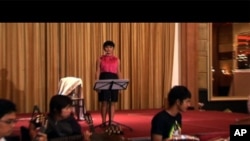Today’s artists are trying to find a way to balance the conservation and the evolution of traditional Cambodian music and dance. Among them are the artists of the La Compagnie Bosbapanh, which recently released two DVDs of a 2009 concert.
The DVD, “Neak Me, or “Our Mothers,” interprets a repertoire of songs, images and dance and features the talent of 12-year-old Panh Bosba and 100 other accomplished Cambodian musicians.
Bosba Panh’s father and artistic director, Panh Meng Heang, told “Hello VOA” on Monday it had been a challenge to bring so many performers to work with a much younger singer.
“It doesn’t mean we’ve diminished our culture,” he said. “We’re actually preserving it. But we play in a way that makes the songs evolve. We want to create new work that puts contemporary and traditional instruments playing together—which gives significance to a culture, to blossom and progress.”
Panh Meng Heang said that in “Neak Me” the traditional song “Boung Soung,” he used a traditional Khmer dance troupe and five different orchestras that mixed traditional music with popular, Western classical and brass band. This ensemble also performed “Concierto de Aranjuez,” “Ave Maria,” La Vie en Rose,” “Summer Time,” traditional Khmer “Mohori” and the songs of former king Norodom Sihanouk and 1960s sensation Sin Sisamouth.
Master Em Theay, who also joined “Hello VOA” on Monday, was a teacher of traditional Khmer singing and dancing at the Royal University of Fine Arts in Phnom Penh. At age 7 she was chosen by the queen at the time, Sisowath Kossomak, to dance at the Royal Palace. She danced and sang for the monarchs for many years until the Khmer Rouge took over the country.
“Art and dance have been very important for Khmer life from ancient times until now,” she said. “Every time I teach the youth the art of dancing, I feel hope for Cambodia’s future. I feel that Khmer choreography is alive and that it will last and continue to develop from this generation to the next.”
She remembered the time she sang for the king and queen at the Royal Palace and taught Sin Sisamouth and Sos Matt, two national icons, to sing “Mohori” for the King.
“The three children of Meng Heang are very talented,” she said. “I didn’t put much effort into teaching any one of them. They learned fast and worked very hard. They are the best students among my students. Khmer arts and culture will not be diminished as long as Cambodia exists on this planet.”
Panh Bosba is now 13 this year. She was raised by her Cambodian father, Panh Meng Heang, and Laotian mother, Lili Sisombath, and educated at a French school. She speaks Khmer, French, and English, but she sings many foreign languages. She plays guitar, violin and piano during her songs. Her uncle is the filmmaker Panh Rithy.




